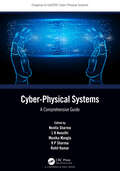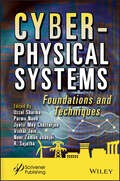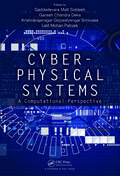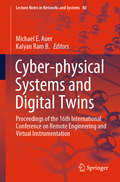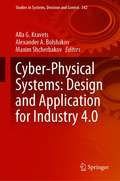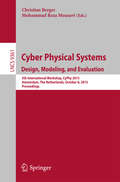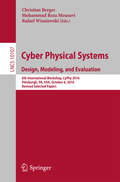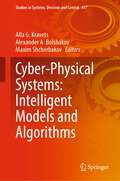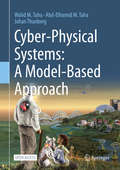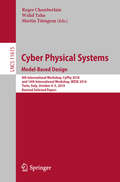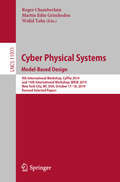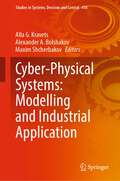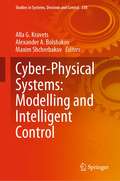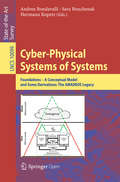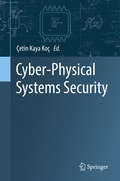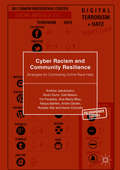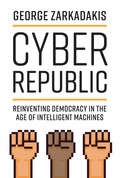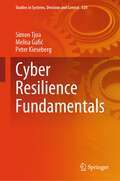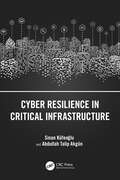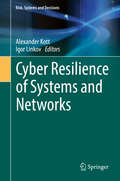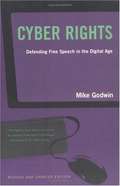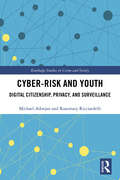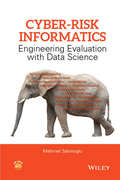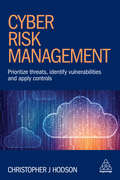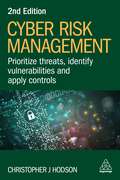- Table View
- List View
Cyber-Physical Systems: A Comprehensive Guide (Chapman & Hall/CRC Cyber-Physical Systems)
by Nonita SharmaCyber-Physical Systems: A Comprehensive Guide explores the complete sys-tem perspective, underlying theories, modelling, and the applications of Cyber Physical Systems (CPS). It aims to cover all topics ranging from discussion of ru-diments of the system, efficient management, to recent research challenges and issues. Editors aim to present the book in a self-sufficient manner and to achieve this, the book has been edited to include all the aspects of CPS. The book fo-cuses on the concept map of CPS including latest technological interventions; issues, challenges, and the integration of CPS with IoT & Big Data Analytics. This aims to bring together unique contributions on cyber-physical systems research and education with applications in industrial, agriculture, and medical domains. The main aim of the book is to provide a roadmap to the latest advancements to provide optimal solutions in the field of CPS. Features • Coverage of rudiments of the subject• Discussion of recent advancements in the associated field• Considers an audience of diverse domains• Suitable for students (both UG and PG level) and researchers in the field of CPS This book aims to present the emergence of Cyber Physical Systems in response to revolutionary advancements in IoT. While discussing the associated challenges, it also endeavors to devise efficient models which are competent to address these challenges. This book aims to cater to researchers and academicians working in the related field of CPS.
Cyber-Physical Systems: Foundations and Techniques (Advances In Computer And Electrical Engineering Ser.)
by Uzzal Sharma Parma Nand Jyotir Moy Chatterjee Vishal Jain Noor Zaman Jhanjhi R. SujathaCYBER-PHYSICAL SYSTEMS The 13 chapters in this book cover the various aspects associated with Cyber-Physical Systems (CPS) such as algorithms, application areas, and the improvement of existing technology such as machine learning, big data and robotics. Cyber-Physical Systems (CPS) is the interconnection of the virtual or cyber and the physical system. It is realized by combining three well-known technologies, namely “Embedded Systems,” “Sensors and Actuators,” and “Network and Communication Systems.” These technologies combine to form a system known as CPS. In CPS, the physical process and information processing are so tightly connected that it is hard to distinguish the individual contribution of each process from the output. Some exciting innovations such as autonomous cars, quadcopter, spaceships, sophisticated medical devices fall under CPS. The scope of CPS is tremendous. In CPS, one sees the applications of various emerging technologies such as artificial intelligence (AI), Internet of Things (IoT), machine learning (ML), deep learning (DL), big data (BD), robotics, quantum technology, etc. In almost all sectors, whether it is education, health, human resource development, skill improvement, startup strategy, etc., one sees an enhancement in the quality of output because of the emergence of CPS into the field. Audience Researchers in Information technology, artificial intelligence, robotics, electronics and electrical engineering.
Cyber-Physical Systems: A Computational Perspective
by Gaddadevara Matt Siddesh Ganesh Chandra Deka Krishnarajanagar GopalaIyengar Srinivasa Lalit Mohan PatnaikIn cyber-physical systems (CPS), sensors and embedded systems are networked together to monitor and manage a range of physical processes through a continuous feedback system. This allows distributed computing using wireless devices. Cyber-Physical Systems-A Computational Perspective examines various developments of CPS that are impacting our daily
Cyber-physical Systems and Digital Twins: Proceedings of the 16th International Conference on Remote Engineering and Virtual Instrumentation (Lecture Notes in Networks and Systems #80)
by Michael Auer Kalyan B.This book constitutes the proceedings of the 16th International Conference on Remote Engineering and Virtual Instrumentation (REV), held at the BMS College of Engineering, Bangalore, India on 3–6 February 2019. Today, online technologies are at the core of most fields of engineering, as well as of society as a whole, and are inseparably connected with Internet of Things,cyber-physical systems,collaborative networks and grids,cyber cloud technologies,service architectures, to name but a few. Since it was first held in, 2004, the REV conference has focused on the increasing use of the Internet for engineering tasks and the problems surrounding it. The 2019 conference demonstrated and discussed the fundamentals, applications and experiences in the field of online engineering and virtual instrumentation. It also presented guidelines for university-level courses on these topics, in view of the increasing globalization of education and the demand for teleworking, remote services and collaborative working environments.
Cyber-Physical Systems: Design and Application for Industry 4.0 (Studies in Systems, Decision and Control #342)
by Alla G. Kravets Alexander A. Bolshakov Maxim ShcherbakovThis book consists of chapters dedicated to the questions of cyber-physical system design and its usage for the chemical industry and new material design. Also, the contribution of the book covers scientific research and their results for cyber-physical systems design and application in the energy domain and solutions regarding engineering education for cyber-physical systems design. The book offers unique content for researchers and practitioners who are looking for new knowledge and skills in the framework of Industry 4.0 solutions. The book also benefits researchers and practitioners in chemistry and new material design and manufacturing to understand how cyber-physical systems can be applied to increase efficiency and performance. The target audience of the book are practitioners, enterprises representatives, scientists, Ph.D. and master students who perform scientific research or applications of cyber-physical systems in the concept of Industry 4.0.
Cyber Physical Systems. Design, Modeling, and Evaluation: 5th International Workshop, CyPhy 2015, Amsterdam, The Netherlands, October 8, 2015, Proceedings (Lecture Notes in Computer Science #9361)
by Mohammad Reza Mousavi Christian BergerThis book constitutes the proceedings of the 5th International Workshop on Design, Modeling, and Evaluation of Cyber Physical Systems, CyPhy 2015, held as part of ESWeek 2015, in Amsterdam, The Netherlands, in October 2015. The 10 papers presented in this volume were carefully reviewed and selected from 13 submissions. They broadly interpret, from a diverse set of disciplines, the modeling, simulation, and evaluation of cyber-physical systems.
Cyber Physical Systems. Design, Modeling, and Evaluation: 6th International Workshop, CyPhy 2016, Pittsburgh, PA, USA, October 6, 2016, Revised Selected Papers (Lecture Notes in Computer Science #10107)
by Mohammad Reza Mousavi Christian Berger Rafael WisniewskiThis book constitutes the proceedings of the 5th International Workshop on Design, Modeling, and Evaluation of Cyber Physical Systems, CyPhy 2015, held as part of ESWeek 2015, in Amsterdam, The Netherlands, in October 2015. The 10 papers presented in this volume were carefully reviewed and selected from 13 submissions. They broadly interpret, from a diverse set of disciplines, the modeling, simulation, and evaluation of cyber-physical systems.
Cyber-Physical Systems: Intelligent Models and Algorithms (Studies in Systems, Decision and Control #417)
by Alla G. Kravets Alexander A. Bolshakov Maxim ShcherbakovThis book is devoted to intelligent models and algorithms as the core components of cyber-physical systems. The complexity of cyber-physical systems developing and deploying requires new approaches to its modelling and design. Presents results in the field of modelling technologies that leverage the exploitation of artificial intelligence, including artificial general intelligence (AGI) and weak artificial intelligence. Provides scientific, practical, and methodological approaches based on bio-inspired methods, fuzzy models and algorithms, predictive modelling, computer vision and image processing. The target audience of the book are practitioners, enterprises representatives, scientists, PhD and Master students who perform scientific research or applications of intelligent models and algorithms in cyber-physical systems for various domains.
Cyber-Physical Systems: A Model-Based Approach
by Walid M. Taha Abd-Elhamid M. Taha Johan ThunbergIn this concise yet comprehensive Open Access textbook, future inventors are introduced to the key concepts of Cyber-Physical Systems (CPS). Using modeling as a way to develop deeper understanding of the computational and physical components of these systems, one can express new designs in a way that facilitates their simulation, visualization, and analysis. Concepts are introduced in a cross-disciplinary way. Leveraging hybrid (continuous/discrete) systems as a unifying framework and Acumen as a modeling environment, the book bridges the conceptual gap in modeling skills needed for physical systems on the one hand and computational systems on the other. In doing so, the book gives the reader the modeling and design skills they need to build smart, IT-enabled products. Starting with a look at various examples and characteristics of Cyber-Physical Systems, the book progresses to explain how the area brings together several previously distinct ones such as Embedded Systems, Control Theory, and Mechatronics. Featuring a simulation-based project that focuses on a robotics problem (how to design a robot that can play ping-pong) as a useful example of a CPS domain, Cyber-Physical Systems: A Model-Based Approach demonstrates the intimate coupling between cyber and physical components, and how designing robots reveals several non-trivial control problems, significant embedded and real-time computation requirements, and a need to consider issues of communication and preconceptions.
Cyber Physical Systems. Model-Based Design: 8th International Workshop, CyPhy 2018, and 14th International Workshop, WESE 2018, Turin, Italy, October 4–5, 2018, Revised Selected Papers (Lecture Notes in Computer Science #11615)
by Roger Chamberlain Walid Taha Martin TörngrenThis book constitutes the proceedings of the 8th International Workshop on Design, Modeling, and Evaluation of Cyber Physical Systems, CyPhy 2018 and 14th International Workshop on Embedded and Cyber-Physical Systems Education, WESE 2018, held in conjunction with ESWeek 2018, in Torino, Italy, in October 2018.The 13 full papers presented together with 1 short paper in this volume were carefully reviewed and selected from 18 submissions. The conference presents a wide range of domains including Modeling, simulation, verification, design, cyber-physical systems, embedded systems, real-time systems, safety, and reliability.
Cyber Physical Systems. Model-Based Design: 9th International Workshop, CyPhy 2019, and 15th International Workshop, WESE 2019, New York City, NY, USA, October 17-18, 2019, Revised Selected Papers (Lecture Notes in Computer Science #11971)
by Walid Taha Roger Chamberlain Martin Edin GrimhedenThis book constitutes the proceedings of the 9th International Workshop on Model-Based Design of Cyber Physical Systems, CyPhy 2019 and 15th International Workshop on Embedded and Cyber-Physical Systems Education, WESE 2019, held in conjunction with ESWeek 2019, in New York City, NY, USA, in October 2019.The 13 full papers presented together in this volume were carefully reviewed and selected from 24 submissions. The conference presents a wide range of domains including models and design; simulation and tools; formal methods; embedded and cyber-physical systems education.
Cyber-Physical Systems: Modelling and Industrial Application (Studies in Systems, Decision and Control #418)
by Alla G. Kravets Alexander A. Bolshakov Maxim ShcherbakovThis book discusses the open questions regarding the modelling of cyber-physical systems and their application in different industries. The industry needs new approaches to improve its competitiveness. The concept of cyber-physical systems supports such changes, with the need to find new modelling tools becoming a key challenge. The book contains five-section covering the following topics: cyber-physical systems modelling, IoT and signal processing, cyber-physical systems intelligent control, cyber-physical systems industrial implementation and the production of the new material for cyber-physical systems. These approaches, on the one hand, should ensure the execution of current business processes, and on the other hand, ensure a quick speed of reactions to changes. The target audience of the book are practitioners, enterprises representatives, scientists, PhD and Master students who perform scientific research on modelling and industrial application of cyber-physical systems.
Cyber-Physical Systems: Modelling and Intelligent Control (Studies in Systems, Decision and Control #338)
by Alla G. Kravets Alexander A. Bolshakov Maxim ShcherbakovThis book highlights original approaches of modelling and intelligent control of cyber-physical systems covering both theoretical and practical aspects. The novel contribution of the book covers the transformation of scientific research and their results into applications for cyber-physical systems design and operation during the whole life cycle in different domains. Given its scope, the book offers an excellent reference book for researchers and other readers in the fields of cyber-physical systems modelling and intelligent control, space exploration and practical implementation of cyber-physical systems. The book also benefits researchers and practitioners in artificial intelligence and machine learning, as described results can be applied in cyber-physical systems design and cost-effectively maintenance. The target audience of this book also includes practitioners and experts, as well as state authorities and representatives of international organizations interested in creating mechanisms for implementing Cyber-Physical Systems projects.
Cyber-Physical Systems of Systems: Foundations – A Conceptual Model and Some Derivations: The AMADEOS Legacy (Lecture Notes in Computer Science #10099)
by Hermann Kopetz Andrea Bondavalli Sara BouchenakThis book is open access under a CC BY 4. 0 license. Technical Systems-of-Systems (SoS) - in the form of networked, independent constituent computing systems temporarily collaborating to achieve a well-defined objective - form the backbone of most of today's infrastructure. The energy grid, most transportation systems, the global banking industry, the water-supply system, the military equipment, many embedded systems, and a great number more, strongly depend on systems-of-systems. The correct operation and continuous availability of these underlying systems-of-systems are fundamental for the functioning of our modern society. The 8 papers presented in this book document the main insights on Cyber-Physical System of Systems (CPSoSs) that were gained during the work in the FP7-610535 European Research Project AMADEOS (acronym for Architecture for Multi-criticality Agile Dependable Evolutionary Open System-of-Systems). It is the objective of this book to present, in a single consistent body, the foundational concepts and their relationships. These form a conceptual basis for the description and understanding of SoSs and go deeper in what we consider the characterizing and distinguishing elements of SoSs: time, emergence, evolution and dynamicity.
Cyber-Physical Systems Security
by Çetin Kaya KoçThe chapters in this book present the work of researchers, scientists, engineers, and teachers engaged with developing unified foundations, principles, and technologies for cyber-physical security. They adopt a multidisciplinary approach to solving related problems in next-generation systems, representing views from academia, government bodies, and industrial partners, and their contributions discuss current work on modeling, analyzing, and understanding cyber-physical systems.
Cyber Racism and Community Resilience: Strategies for Combating Online Race Hate (Palgrave Hate Studies)
by Karen Connelly Andrew Jakubowicz Kevin Dunn Gail Mason Yin Paradies Ana-Maria Bliuc Nasya Bahfen Andre Oboler Rosalie AtieThis book highlights cyber racism as an ever growing contemporary phenomenon. Its scope and impact reveals how the internet has escaped national governments, while its expansion is fuelling the spread of non-state actors. In response, the authors address the central question of this topic: What is to be done? Cyber Racism and Community Resilience demonstrates how the social sciences can be marshalled to delineate, comprehend and address the issues raised by a global epidemic of hateful acts against race. Authored by an inter-disciplinary team of researchers based in Australia, this book presents original data that reflects upon the lived, complex and often painful reality of race relations on the internet. It engages with the various ways, from the regulatory to the role of social activist, which can be deployed to minimise the harm often felt. This book will be of particular interest to students and academics in the fields of cybercrime, media sociology and cyber racism.
Cyber Republic: Reinventing Democracy in the Age of Intelligent Machines
by George ZarkadakisScience and tech expert George Zarkadakis presents an indispensable guide to making liberal democracies more inclusive, and the digital economy more equitable in the coming Fourth Industrial Revolution.Around the world, liberal democracies are in crisis. Citizens have lost faith in their government; right-wing nationalist movements frame the political debate. At the same time, economic inequality is increasing dramatically; digital technologies have created a new class of super-rich entrepreneurs. Automation threatens to transform the free economy into a zero-sum game in which capital wins and labor loses. But is this digital dystopia inevitable? In Cyber Republic, George Zarkadakis presents an alternative, outlining a plan for using technology to make liberal democracies more inclusive and the digital economy more equitable. Cyber Republic is no less than a guide for the coming Fourth Industrial Revolution.
Cyber Resilience Fundamentals (Studies in Systems, Decision and Control #520)
by Simon Tjoa Melisa Gafić Peter KiesebergThis book provides readers with the necessary capabilities to meet the challenge of building and testing resilient IT services. Upon introducing the fundamentals of cyber resilience with important international standards and best practices, and the risk management process, the book covers in detail the cyber resilience management process. Here, it gives insights into the principles and design criteria to build cyber resilience in organizations, and to integrate it into operations to contribute to incident preparedness. Further, it describes measures for incident handling, including detection, containment, and post-incident handling, and analyses the most critical aspects of cyber resilience testing, such as auditing, exercising, and testing. Written for advanced undergraduate students attending information security and business continuity management courses, this book also addresses researchers and professionals in the broad field of IT Security and cyber resilience.
Cyber Resilience in Critical Infrastructure
by Sinan Küfeoğlu Abdullah Talip AkgünCritical infrastructure sectors are those whose assets, systems, and networks, whether physical or virtual, are deemed so important to nations that their incapacitation or destruction would have a crippling effect on national security, national economic security, national public health or safety, or any combination of these. Each country might define their unique critical infrastructure. In this book, we compiled nine critical infrastructure sectors: Emergency Services, Energy, Finance, Food, Government, Health, Telecommunications, Transport, and Water. The continuity of services in these sectors is vital for the daily lives of societies and economies. This study introduces 49 case studies from various parts of the world. This book investigates Cyber Resilience in Critical Infrastructure by paying attention to recommending a national-level cyber resilience framework for all nations to use. Furthermore, we present sectoral analysis and case studies for each infrastructure by going through an in-depth analysis. As military tensions grow in many parts of the world, nations are alarmed and focused on their national cyber resilience, especially the reliability of their critical infrastructure. We believe this book will be a popular reference and guidebook for a wide range of readers worldwide, from governments to policymakers, from industry to the finance sector, and many others.
Cyber Resilience of Systems and Networks (Risk, Systems and Decisions)
by Igor Linkov Alexander KottThis book introduces fundamental concepts of cyber resilience, drawing expertise from academia, industry, and government. Resilience is defined as the ability to recover from or easily adjust to shocks and stresses. Unlike the concept of security - which is often and incorrectly conflated with resilience -- resilience refers to the system's ability to recover or regenerate its performance after an unexpected impact produces a degradation in its performance. A clear understanding of distinction between security, risk and resilience is important for developing appropriate management of cyber threats. The book presents insightful discussion of the most current technical issues in cyber resilience, along with relevant methods and procedures. Practical aspects of current cyber resilience practices and techniques are described as they are now, and as they are likely to remain in the near term.The bulk of the material is presented in the book in a way that is easily accessible to non-specialists. Logical, consistent, and continuous discourse covering all key topics relevant to the field will be of use as teaching material as well as source of emerging scholarship in the field. A typical chapter provides introductory, tutorial-like material, detailed examples, in-depth elaboration of a selected technical approach, and a concise summary of key ideas.
Cyber Rights: Defending Free Speech in the Digital Age
by Mike GodwinLawyer and writer Mike Godwin has been at the forefront of the struggle to preserve freedom of speech on the Internet. In Cyber Rights he recounts the major cases and issues in which he was involved and offers his views on free speech and other constitutional rights in the digital age. Godwin shows how the law and the Constitution apply, or should apply, in cyberspace and defends the Net against those who would damage it for their own purposes. Godwin details events and phenomena that have shaped our understanding of rights in cyberspace--including early antihacker fears that colored law enforcement activities in the early 1990s, the struggle between the Church of Scientology and its critics on the Net, disputes about protecting copyrighted works on the Net, and what he calls "the great cyberporn panic." That panic, he shows, laid bare the plans of those hoping to use our children in an effort to impose a new censorship regime on what otherwise could be the most liberating communications medium the world has seen. Most important, Godwin shows how anyone--not just lawyers, journalists, policy makers, and the rich and well connected--can use the Net to hold media and political institutions accountable and to ensure that the truth is known.
Cyber-risk and Youth: Digital Citizenship, Privacy and Surveillance (Routledge Studies in Crime and Society)
by Michael Adorjan Rosemary RicciardelliCyber-risks are moving targets and societal responses to combat cyber-victimization are often met by the distrust of young people. Drawing on original research, this book explores how young people define, perceive, and experience cyber-risks, how they respond to both the messages they are receiving from society regarding their safety online, and the various strategies and practices employed by society in regulating their online access and activities. This book complements existing quantitative examinations of cyberbullying assessing its extent and frequency, but also aims to critique and extend knowledge of how cyber-risks such as cyberbullying are perceived and responded to. Following a discussion of their methodology and their experiences of conducting research with teens, the authors discuss the social network services that teens are using and what they find appealing about them, and address teens’ experiences with and views towards parental and school-based surveillance. The authors then turn directly to areas of concern expressed by their participants, such as relational aggression, cyberhacking, privacy, and privacy management, as well as sexting. The authors conclude by making recommendations for policy makers, educators and teens – not only by drawing from their own theoretical and sociological interpretations of their findings, but also from the responses and recommendations given by their participants about going online and tackling cyber-risk. One of the first texts to explore how young people respond to attempts to regulate online activity, this book will be key reading for those involved in research and study surrounding youth crime, cybercrime, youth culture, media and crime, and victimology – and will inform those interested in addressing youth safety online how to best approach what is often perceived as a sensitive and volatile social problem.
Cyber-Risk Informatics: Engineering Evaluation with Data Science
by Mehmet SahinogluThis book provides a scientific modeling approach for conducting metrics-based quantitative risk assessments of cybersecurity vulnerabilities and threats. This book provides a scientific modeling approach for conducting metrics-based quantitative risk assessments of cybersecurity threats. The author builds from a common understanding based on previous class-tested works to introduce the reader to the current and newly innovative approaches to address the maliciously-by-human-created (rather than by-chance-occurring) vulnerability and threat, and related cost-effective management to mitigate such risk. This book is purely statistical data-oriented (not deterministic) and employs computationally intensive techniques, such as Monte Carlo and Discrete Event Simulation. The enriched JAVA ready-to-go applications and solutions to exercises provided by the author at the book's specifically preserved website will enable readers to utilize the course related problems. * Enables the reader to use the book's website's applications to implement and see results, and use them making 'budgetary' sense * Utilizes a data analytical approach and provides clear entry points for readers of varying skill sets and backgrounds * Developed out of necessity from real in-class experience while teaching advanced undergraduate and graduate courses by the author Cyber-Risk Informatics is a resource for undergraduate students, graduate students, and practitioners in the field of Risk Assessment and Management regarding Security and Reliability Modeling. Mehmet Sahinoglu, a Professor (1990) Emeritus (2000), is the founder of the Informatics Institute (2009) and its SACS-accredited (2010) and NSA-certified (2013) flagship Cybersystems and Information Security (CSIS) graduate program (the first such full degree in-class program in Southeastern USA) at AUM, Auburn University's metropolitan campus in Montgomery, Alabama. He is a fellow member of the SDPS Society, a senior member of the IEEE, and an elected member of ISI. Sahinoglu is the recipient of Microsoft's Trustworthy Computing Curriculum (TCC) award and the author of Trustworthy Computing (Wiley, 2007).
Cyber Risk Management: Prioritize Threats, Identify Vulnerabilities and Apply Controls
by Christopher HodsonMost organizations are undergoing a digital transformation of some sort and are looking to embrace innovative technology, but new ways of doing business inevitably lead to new threats which can cause irreparable financial, operational and reputational damage. In an increasingly punitive regulatory climate, organizations are also under pressure to be more accountable and compliant. Cyber Risk Management clearly explains the importance of implementing a cyber security strategy and provides practical guidance for those responsible for managing threat events, vulnerabilities and controls, including malware, data leakage, insider threat and Denial-of-Service. Examples and use cases including Yahoo, Facebook and TalkTalk, add context throughout and emphasize the importance of communicating security and risk effectively, while implementation review checklists bring together key points at the end of each chapter. Cyber Risk Management analyzes the innate human factors around risk and how they affect cyber awareness and employee training, along with the need to assess the risks posed by third parties. Including an introduction to threat modelling, this book presents a data-centric approach to cyber risk management based on business impact assessments, data classification, data flow modelling and assessing return on investment. It covers pressing developments in artificial intelligence, machine learning, big data and cloud mobility, and includes advice on responding to risks which are applicable for the environment and not just based on media sensationalism.
Cyber Risk Management: Prioritize Threats, Identify Vulnerabilities and Apply Controls
by Christopher J HodsonHow can you manage the complex threats that can cause financial, operational and reputational damage to the business? This practical guide shows how to implement a successful cyber security programme. The second edition of Cyber Risk Management covers the latest developments in cyber security for those responsible for managing threat events, vulnerabilities and controls. These include the impact of Web3 and the metaverse on cyber security, supply-chain security in the gig economy and exploration of the global, macroeconomic conditions that affect strategies. It explains how COVID-19 and remote working changed the cybersecurity landscape.Cyber Risk Management presents a data-centric approach to cyber risk management based on business impact assessments, data classification, data flow modelling and assessing return on investment. It covers pressing developments in artificial intelligence, machine learning, big data and cloud mobility, and includes advice on dealing with malware, data leakage, insider threat and Denial-of-Service. With analysis on the innate human factors affecting cyber risk and awareness and the importance of communicating security effectively, this book is essential reading for all risk and cybersecurity professionals.
